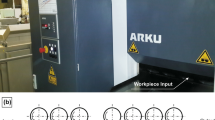This article discusses the changes in the microstructure and properties of brass billets for antifriction rings under intense plastic deformation caused by high-torsion under in a combined matrix. Deformation experiment was performed at room temperature for six cycles. Results revealed that from the initial state, brass showed a threefold increase in strength and microhardness (from 820 MPa to 2115 MPa) after deformation. The greatest increase in strength properties occurred during the first two deformation cycles.




Similar content being viewed by others
References
A. V. Zinoviev, A. N. Koshmin, and A. Ya. Chasnikov, “ Influence of the parameters of the process of continuous pressing on the formation of the microstructure and the mechanical properties of round rods from alloy M1,” Metallurg, No. 4, 16–23 (2019).
I. E. Volokitina and G. G. Kurapov, “ Effect of initial structural state on formation of structure and mechanical properties of steels under ECAP,” Metal Sci. Heat Treat., 59(11/12), 786–792 (2018).
P. Eslami and Taheri A. Karimi, “An investigation on diffusion bonding of aluminum to copper using equal channel angular extrusion process,” Mater. Lett., 65, 1862–1864 (2011).
A. Boikov, V. Payor, R. Savelev, and A. Kolesnikov, “ Synthetic data generation for steel defect detection and classification using deep learning,” Symmetry, 13(7), 1176 (2021).
G. Raab, R. Valiev, T. Lowe, and Y. Zhu, “Continuous processing of ultrafine grained A1 by ECAP-Conform,” Mater. Sci. Eng., 382, 30–34 (2004).
I. Volokitina, A. Naizabekov, E. Panin, and A. Volokitin, “Effect of ECAP-drawing on the microstructure of a bimetallic wire,” Metallurgist, 65 (7/8), 769–774 (2021).
A. Naizabekov and I. Volokitin, “Effect of the initial structural state of Cr–Mo high-temperature steel on mechanical properties after equal-channel angular pressing,” Phys. Met. Metallogr., 120, 177–183 (2019).
A. Bachmaier, T. Grosdidier, and Y. Ivanisenko, “Severe plastic deformation and thermomechanical processing: nanostructuring and properties,” Metals, 10, 1306 (2020).
G. Raab, R. Valiev, T. Lowe, and Y. Zhu, “Continuous processing of ultrafine grained A1 by ECAP-Conform,” Mater. Sci. Eng., 382, 30–34 (2004).
Z. Horita, T. Fujinami, and T. Langdon, “The potential for scaling ECAP: Effect of sample size on grain refinement and mechanical properties,” Mater. Sci. Eng. A., 318 (1/2), 34–41 (2001).
R. Valiev, Y. Estrin, Z. Horita, T. Langdon, M. Zehetbauer, and Y. Zhu, “Producing bulk ultrafine-grained materials by severe plastic deformation: ten years later,” J. Met., 68, 1216–1226 (2016).
M. Polyakova, A. Gulin, and D. Constantinov, “Investigation of microstructure and mechanical properties of carbon steel wire after continuous method of deformational nanostructuring,” Appl. Mech. Mater., 436, 11–120 (2013).
M. Kawasaki, B. Ahn, H. J. Lee, A. P. Zhilyaev, and T. G. Langdon, “ Using high-pressure torsion to process an aluminummagnesium nanocomposite through diffusion bonding,” J. Mater. Res., 31, 8–99 (2015).
I. Choi, R. Schwaiger, L. Kurmanaeva, and O. Kraft, “On the effect of Ag content on the deformation behavior of ultrafine-grained Pd–Ag alloys,” Scr. Mater., 61, 64–67 (2009).
R. Z. Valiev, R. K. Islamgaliev, and I. V. Alexandrov, “Bulk nanostructured materials from severe plastic deformation,” Prog. Mater. Sci., 45, 103–189 (2000).
A. Zhilyaev and T. Langdon, “Using high-pressure torsion for metal processing: Fundamentals and applications,” Prog. Mater. Sci., 53, 893–979 (2008).
R. Z. Valiev, Y. Estrin, Z. Horita, T. G. Langdon, M. J. Zehetbauer, and Y. T. Zhu, “ Producing bulk ultrafine-grained materials by severe plastic deformation,” J. Met., 58, 33–39 (2006).
M. Yu. Murashkin, I. Sabirov, and V. U. Kazykhanov, “ Enhanced mechanical properties and electrical conductivity in ultrafinegrained Al alloy processed via ECAP-PC,” J. Mater. Sci., 48, 4501–4509 (2013).
M. Dao, L. Lu, R. Asaro, J. Hosson, and E. Ma, “ Toward a quantitative understanding of mechanical behavior of nanocrystalline metals,” Acta Mater., 55, 4041–4065 (2007).
O. L. Khasanov, E. S. Dvilis, and Z. G. Bikbaeva, Methods of Compaction and Consolidation of Nanostructured Materials and Products, Publishing House of Tomsk Polytechnic University, Tomsk (2008).
C. Xu, Z. Horita, and T. G. Langdon, “The evolution of homogeneity in processing by high-pressure torsion,” Acta Mater., 55, 203–212 (2007).
S. Erbel, “Mechanical properties and structure of extremely strain-hardened copper,” Met. Technol., 6, 482–486 (1979).
A. P. Zhilyaev, G. Ringot, Yi. Huang, J. M. Cabrera, and T. G. Langdon, “ Mechanical behavior and microstructure properties of titanium powder consolidated by high-pressure torsion,” Mater. Sci. Eng. A., 688, 498–504 (2017).
A. Volokitin, I. Volokitina, E. Panin, A. Naizabekov, and S. Lezhnev, “Strain state and microstructure evolution of AISI-316 austenitic stainless steel during high-pressure torsion (HPT) process in the new stamp design,” Metalurgija, 60 (3/4), 325–328 (2021).
Author information
Authors and Affiliations
Corresponding author
Additional information
Translated from Metallurg, Vol. 66, No. 12, pp. 81–85, December, 2022. Russian DOI:https://doi.org/10.52351/00260827_2022_12_81.
Rights and permissions
Springer Nature or its licensor (e.g. a society or other partner) holds exclusive rights to this article under a publishing agreement with the author(s) or other rightsholder(s); author self-archiving of the accepted manuscript version of this article is solely governed by the terms of such publishing agreement and applicable law.
About this article
Cite this article
Volokitina, I.E., Volokitin, A.V., Kolesnikov, A.S. et al. Effect of Deformation by High-Pressure Torsion in a Combined Matrix on the Properties of Brass. Metallurgist 66, 1601–1606 (2023). https://doi.org/10.1007/s11015-023-01475-7
Received:
Revised:
Accepted:
Published:
Issue Date:
DOI: https://doi.org/10.1007/s11015-023-01475-7




